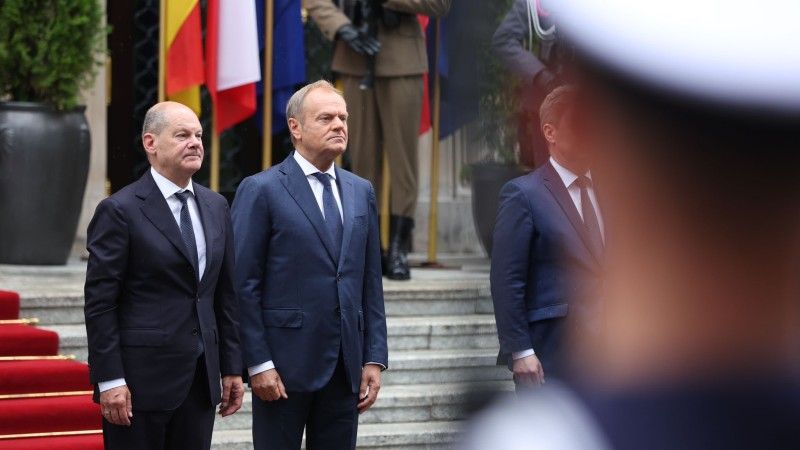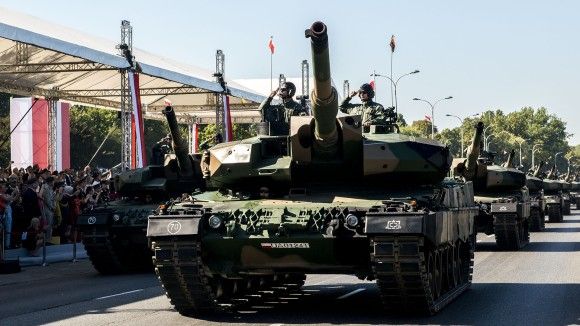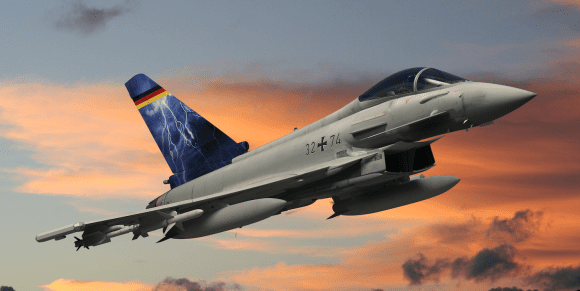Joint Polish-German Defensive Effort? Berlin Must Put In More Work

Photo. Donald Tusk/X
Yesterday’s intergovernmental consultation held between Poland and Germany also covered the defence issues. Despite the fact both nations have been working for years, a new beginning may be on the horizon - assuming that both parties are properly involved and that Germany would be eager to provide financial support.
The Polish Ministry of Defence issued a laconic release, claiming that the meeting between the defence ministers covered the bilateral relations within the scope of defence, and EU and NATO security, with the Ministers discussing the NATO Summit in Washington planned in July, and the border security matters. It is not a secret that within the framework of the Polish-German G2G dialogue, security, broadly understood, has been one of the key matters discussed.
First, it is worth noting that Poland and Germany have been working within the scope of defence ever since Poland’s NATO accession. Multinational Corps Northeast based in Szczecin is a symbol of this collaboration. In 2014 the element increased the levels of its combat readiness. The Corps is commanded, on a rotational basis, by Polish, German, and Danish generals. General Jürgen-Joachim von Sandrart, the current Corps commander (who also participated in the recent Defence24 Days conference) has been making multiple warnings about the Russian threats, indicating that there is a necessity to undertake more urgent, and broader action, than what is being done today.
Is the phrase „We defend every inch of NATO“ just a lip service? Recently I could share some remarks in that respect. For me, the answer to this provocative question lies in my back – the rear area. Please find hereby my thoughts. At the end, we have to be #StrongerTogether pic.twitter.com/pBmOfdzOpJ
— Jürgen-Joachim von Sandrart (@vonSandrart) June 28, 2024
The problem is, that although German Defence Minister Boris Pistorius may agree with such statements (and similar warning signals from the Bundeswehr), Chancellor Olaf Scholz and members of the coalition oppose the decisive involvement in the expansion of defence potential, worrying about the cost of that effort, and the necessity to cut on welfare (and poking “the Russian bear”, despite the declarations made on deterring Moscow). This has been exemplified by the recent dispute between Poland and Germany, on financing the development of defence capabilities with the use of EU funding. Germany is a strong opponent of this scenario, not willing to increase the debt levels.
The Polish Armed Forces operate the German-made Leopard 2 main battle tanks, Armed Forces of both nations have been frequently involved in joint exercises and operations, within the framework of reinforcing NATO’s Eastern Flank. Back in 2023 German Patriot missiles were temporarily deployed to Poland, while Luftwaffe’s Eurofighter jets and A400M tanker aircraft were involved in CAP duty in the Polish airspace. Some of the post-Soviet equipment that has been, up until recently, operated by the Polish Armed Forces, and transferred to Ukraine later on, was gifted to Poland by Germany. This includes MiG-29 fighter aircraft and Mi-24D helicopters from former GDR.

Photo. Mirosław Mróz
The above does not change the fact that cooperation between the two nations has not been moving along too smoothly in recent years, primarily following the NATO format. There are a couple of reasons for that. The first one is related to the cuts in the Bundeswehr, which led to a degradation of the German potential, also within the scope of providing maintenance for the Leopard 2A4 main battle tanks still operated by Poland - along with the German defence industry’s costs increase, indirectly stemming from the aforesaid cuts. This, along with the peculiar stance adopted by the German industry, and problems on the Polish side, translated into many years of backlog in the implementation of the Leopard 2A4 upgrades (up to the Leopard 2PL standard).
Cuts in Poland, happening up until 2013, also had their share here. Furthermore, during the first Donald Tusk term, Berlin was offering 8 to 12 Patriot PAC-2 batteries to Poland. This was not considered to be prospective, and Warsaw focused on the Wisła programme instead. The Patriot systems mentioned above are now in service in Jordan, Spain, Turkey, and Israel. The third reason is the less-than-good political relationship between Poland and Germany, which was the case during the previous term of the Polish government. But the political reasons were not the key cause for Poland already having 100 Abrams MBTs, instead of Leopards - the latter were simply unavailable, in a physical form. After the change in power, there are still some dispute-causing areas in the area of security, within the scope of financing, or border protection for instance.
The current government hopes to reset the relationship with Berlin. Germany also has some hope within that scope. The German defence industry, despite all of its problems, is still growing its potential - modest domestic procurement or even the Ukrainian contracts are not exhausting that capacity, even though more and more deals are concluded, involving Kyiv. Some of the German political circles are eager to strengthen national security, although the policy lacks coherence. What are the potential areas then, in which both nations could bolster their cooperation?
1. Air Defence
Air Defence is the first area that needs to be mentioned here - PM Donald Tusk did make some remarks here as well. Poland could join the European Sky Shield Initiative and procure missiles designed for intercepting ballistic threats outside the Earth’s atmosphere (Israeli Arrow 3), or even participate in joint procurement of Patriot missiles. Germany, meanwhile, could make steps towards procuring the IBCS air defence management system - already being commissioned in Poland. The German procurement could also include Polish components or even radars. German IBCS acquisition is likely. To maintain the Patriot’s interoperability, and utilize all of its capabilities, IBCS is a must, sooner or later. Northrop Grumman is offering IBCS as a baseline foundation for the NATO ESSI programme. All of the above could happen without any impact on the Wisła, Narew, and Pilica programmes pursued so far. Why is this the way to go? There are no plans in place, to procure missiles that could engage targets in outer space. Patriots will be owned by both Germany and Poland. Lower-tier air defences could be developed independently.
In the air defence domain, some limitations influence what Germany can do. Berlin decided to establish Patriot PAC-2 GEM-T manufacturing capacity (with components coming from the US) and place it in the hands of the MBDA-Raytheon consortium. 1,000 missiles are to be delivered between 2027 and 2023, 50% of which will be procured by Germany. If the order grows, modernization of those missiles could be an option, addressing the known disadvantages (a new active seeker could be introduced, independent from the Patriot radar). This could also entail a stronger supply chain, offering some economy mobilization headroom, should the threat levels continue to grow. The key problem NATO member states struggle with is quantitatively insufficient procurement, which translates into much longer delivery timelines. If a demand occurs, the manufacturing output can be multiplied over a couple of years, as it happens for the German IRIS-T/IRIS-T SL missiles operated in Ukraine for instance. Manufacturing output has been several times higher, compared to 2022.
Between 1980 and 1991, the US Army bought 6,285 Patriot missiles of all varieties (mostly PAC-1/2s). (another 195 missiles were bought after 1991, not shown here). For comparison, between 2000-2024, the US Army bought 3,779 Patriot missiles (2,656 PAC-3 MSEs and 1,124 PAC-3 CRIs) pic.twitter.com/2GGLqcdK6w
— Zach (@ThrustWR) June 30, 2024
For the more expensive Patriot missile, this does not seem to be the case though. The United States, with 60 Patriot batteries, procured more than 6 thousand missiles as such (legacy ones) during the Cold War. Germany plans to operate at least 16 Patriot SAM systems. Even if the modern PAC-3 MSE missiles are procured, no „Cold War” stockpile levels of 100 missiles per fire unit can be attained. In the circumstances in which the threat levels are on the rise, the stock should be bigger, not smaller. Co-financing the procurement of another 500 missiles for Poland seems to be far-fetched, to say the least.
2. Navy Modernization
Modernization of the Polish Navy is another interesting area, where potential cooperation could happen. Germany is involved in the Polish Orka submarine procurement with their 212CD design. Joint operations in the Baltic Sea could be a big advantage of that offer. There is a question that can be asked about co-funding that procurement, like in the case of the German vessels built for Israel (with industrial participation of the Israeli entities). Will the Germans be eager to pursue that solution? And will the German bid be interesting enough, with France and South Korea also fighting to win this procurement?
3. Air Force Modernization
Modernization of Polish military aviation is the third domain where potential cooperation could happen. This refers primarily to the Eurofighter Typhoon MRCA, offered to Poland. A question may arise, whether Germany would limit their bid to a conventional industrial proposal, together with other partner nations, supported by the Armed Forces Support Fund, or would they be willing to provide Poland with more benefits? Poland would need serious training and logistics-related support in commissioning another type of MRCA. NATO, and the Eastern Flank nations, have an urgent need to procure specialist EW/ELINT/reconnaissance aircraft.
Germany has been a leading NATO nation in that domain since the Cold War. Berlin recently procured the first 15 Eurofighter EK EW aircraft, expected to replace the legacy Tornado ECRs. And the number of those jets should be much higher, considering the risk of losses, or the needs expressed by the allies. The situation here is very much similar to the one in the air defence domain. There is some potential for cooperation, or even rotational deployment of German units in Poland, to train the EW systems operators and solidify the capabilities. To make use of that potential, Berlin would need to make a deeper commitment to expanding the potential of its own. The German industrial offer in the realm of EW/ELINT is not limited to the air domain.

Photo. Eurofighter
One should add that Germany is a major stakeholder in Airbus. Airbus has two proposals for Poland, in important (yet not so spectacular) air domain procurements - the Karkonosze MRTT programme, and the training helicopter procurement (H145M). These are another two areas in which cooperation could happen. Considering the scope within which the offered platforms are used in NATO, this logistics and training offer may bring more added value, than the “spectacular” defence tenders.
Another potential area of cooperation, tied to the helicopter procurement, and involving another country - the USA, with Boeing leading the way - also exists. It concerns two helicopter types. On one hand, Germany has already procured 60 Chinook heavy cargo helicopters. A smaller procurement of these aircraft is also considered by Poland. Warsaw, on the other hand, is planning to procure 96 Apache Guardian gunships. Meanwhile, Germany still needs 24 to 32 conventional attack helicopters to replace the Tigers. The question emerging here pertains to coordination and logistics (Poland is the lead nation for Apache, and Germany for Boeing). Joint efforts will also be needed in the operation of the F-35.
4. Munitions and Land Forces Equipment, Expansion of the Defence Industry
Expansion of Polish-German cooperation in the land domain equipment is also possible. „Die Welt” has been making general remarks on the possible launch of a Rheinmetall plant in Poland. The company is quite active here. As procurement of German main battle tanks or self-propelled howitzers would not be rational, with modernization programmes in these areas being already underway, and with long delivery timelines in the case of German products, other potential areas for cooperation exist.
One of them includes munitions manufacturing. Not necessarily the 155 mm artillery rounds, as domestic potential for growth here is significant, with numerous partners, but rather in the area of rocket artillery munitions. A question arises whether the Polish PGZ Group companies will be able to pick up the burden (and handle the costs) involved in establishing large-scale GMLRS rockets manufacturing (not just assembly). These are used both in the Polish HIMARS systems, as well as in the German M270 MARS II MLRS, and the future GMARS platforms. Potentially, establishing a complete German-Polish supply chain is an option here - with that chain being independent of the US manufacturing potential. Rheinmetall is in very good financial shape, it can also provide capital for such undertakings. The German company could also offer the Lynx IFV to Poland, as a base platform for the heavy IFV expected to be designed by PGZ. Lynx is also being sold to Hungary and Ukraine.

Photo. Rheinmetall
There are numerous areas in which Poland and Germany could work together, when it comes to defence, as we can clearly see. There are multiple issues as well. The key one stems from the German reluctance to invest funds in Germany’s capabilities (which would make Berlin more credible as a partner) and in the reinforcement of the allied potential. Given Berlin’s economic potential, and the status of state finances, attained also thanks to long-term cuts in the Bundeswehr, this is not an impossible development. What is missing is the political determination. Without additional German support, also tied to rapid expansion of the manufacturing potential for both dumb and smart munitions (like guided rockets), and EW systems, the defensive potential of NATO in the east may simply be weakened. This would make the German industrial offer less attractive which does not exclude cooperation where benefits could be created.
The lack of German approval for new funds allowing for establishing new defence capabilities is of concern here. Maybe a consensus can be reached, with some unused funds from the national recovery plans, but this is not a certain scenario. Without that, it may turn out that procuring weapons in the US, with FMF support, would be a better option in many cases. This is what the German ally needs to be aware of.
There is one more issue worth mentioning. During the Cold War, West Germany was gradually increasing its military potential, but with strong US support - not just through military presence, but also through the transfer of equipment, including costly assets. Recently we have seen a celebration of the 40th anniversary of the Patriot-Roland Vertrag deal. This deal made it possible for the German taxpayer to pay only for 12 out of 36 operational Patriot batteries commissioned in the Bundeswehr towards the end of the Cold War. The remainder was either US-provided or US-owned, with maintenance and servicing done by the German soldiers. Germany also committed to procuring Roland SAMs to protect some of the US bases.
A similar formula, assuming that Polish capabilities would be supported has not been mentioned by Berlin - and such a solution would also be beneficial for the defence of Germany and its forward units deployed to Lithuania. This is also prominent, given the Polish-German history, and a lack of proper WWII compensation. During the Cold War, the USA has been investing in the German military, protecting its interest, at a major expense. What is Germany Doing Now?
If Berlin wants to take greater responsibility for a joint defensive effort - and this is what the allies and the Republicans in the US expect - it needs to agree to redirect more funds and assets to that effort. Also when helping the allies, or co-financing the procurement. If no decision as such is made, despite the warmer relations it may turn out that Polish-German defensive cooperation would not be a breakthrough the allies need. One or two agreements would not change a thing. Similar statements may be made regarding other initiatives. Although valuable, they are not as far outreaching, as the EU’s project aimed at increasing the military mobility, mentioned in the documents after the consultation. Fusion of the potentials of both nations is objectively needed, to increase the overall deterrence capability. Some of the highly-ranked German officers are warning everybody else, about the Russian threat - like the aforesaid General von Sandart. The German politicians seem to have a different set of priorities now.



